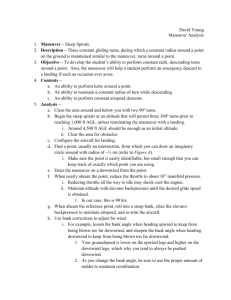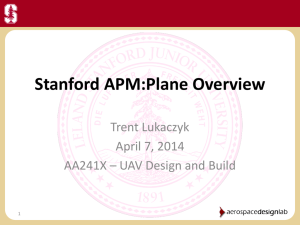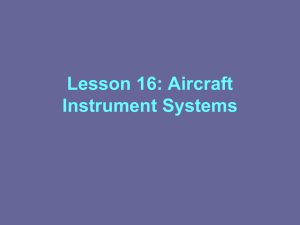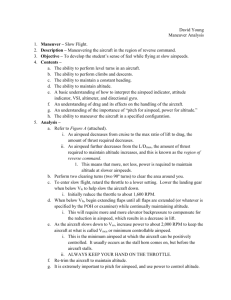GPS PEC Method
advertisement
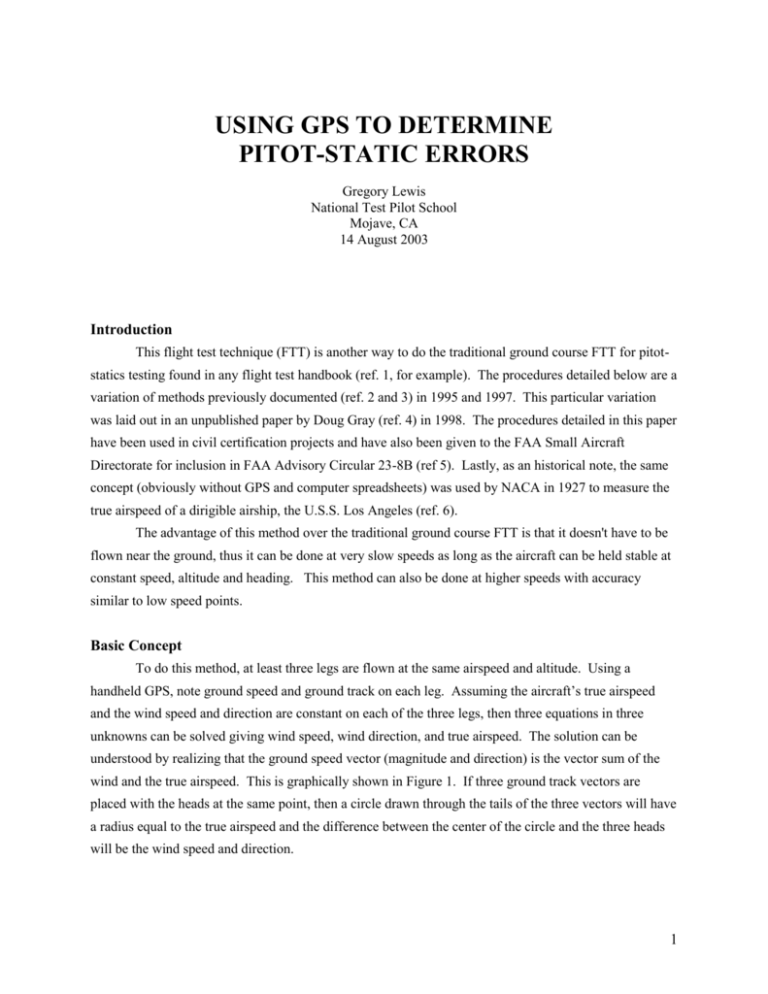
USING GPS TO DETERMINE PITOT-STATIC ERRORS Gregory Lewis National Test Pilot School Mojave, CA 14 August 2003 Introduction This flight test technique (FTT) is another way to do the traditional ground course FTT for pitotstatics testing found in any flight test handbook (ref. 1, for example). The procedures detailed below are a variation of methods previously documented (ref. 2 and 3) in 1995 and 1997. This particular variation was laid out in an unpublished paper by Doug Gray (ref. 4) in 1998. The procedures detailed in this paper have been used in civil certification projects and have also been given to the FAA Small Aircraft Directorate for inclusion in FAA Advisory Circular 23-8B (ref 5). Lastly, as an historical note, the same concept (obviously without GPS and computer spreadsheets) was used by NACA in 1927 to measure the true airspeed of a dirigible airship, the U.S.S. Los Angeles (ref. 6). The advantage of this method over the traditional ground course FTT is that it doesn't have to be flown near the ground, thus it can be done at very slow speeds as long as the aircraft can be held stable at constant speed, altitude and heading. This method can also be done at higher speeds with accuracy similar to low speed points. Basic Concept To do this method, at least three legs are flown at the same airspeed and altitude. Using a handheld GPS, note ground speed and ground track on each leg. Assuming the aircraft’s true airspeed and the wind speed and direction are constant on each of the three legs, then three equations in three unknowns can be solved giving wind speed, wind direction, and true airspeed. The solution can be understood by realizing that the ground speed vector (magnitude and direction) is the vector sum of the wind and the true airspeed. This is graphically shown in Figure 1. If three ground track vectors are placed with the heads at the same point, then a circle drawn through the tails of the three vectors will have a radius equal to the true airspeed and the difference between the center of the circle and the three heads will be the wind speed and direction. 1 Figure 1. Vector Analysis The solution of the equations is easily accomplished using a computer spreadsheet. The general solution has been shown by Doug Gray in his paper (ref. 3). A downloadable Excel solution, “GPS_PEC.xlw” is available on the National Test Pilot School’s website: www.ntps.edu/downloads.htm. Pitot-Static Error Determination The GPS-derived true airspeed is then used to determine the pitot-static error by comparing it to the indicated speed, corrected to true, using the following relationship: Vi Vic V pec Vc Vtrue where: Vi is the indicated speed on each of the three legs Vic is the calibration instrument correction for the airspeed indicator Vpec is our unknown position error correction Vc is the scale altitude correction factor (insignificant below 5,000 ft and 250 kts) Vtrue is the true airspeed determined from the three GPS legs is the test day density ratio A spreadsheet in the above mentioned Microsoft Excel workbook (GPS_PEC.xlw) will do the above calculations. Altitude error, Hpec, is calculated assuming all of the error is in the static port, exactly as is done in the traditional ground course method. 2 Inflight Procedures To fly the FTT: 1. Perform a stable trim shot at the desired airspeed and configuration. Pick an altitude and geographic location where you would expect steady wind. 2. Once stable, note everything that would affect true airspeed (indicated airspeed, pressure altitude, and outside air temperature). 3. After allowing sufficient settling time (perhaps 10 seconds after the aircraft is stable, no change in ground speed or track), record the GPS ground speed and track. 0 0 4. Turn 60 to 120 and repeat step 3 at the same airspeed and altitude. Small changes in altitude are much preferred over any change in airspeed. A one knot speed error will produce one knot or more error in true airspeed, but a 100 ft error in altitude will have a relatively insignificant error on true airspeed. A constant ground track is important. 5. Turn again and repeat at the same airspeed and altitude. Three legs are required to complete one data point (one speed/configuration). If four legs are done at the same conditions then the data can be averaged taking four legs, three at a time, four different ways. GPS Receiver Equipment There is no technical requirement to use a specially certified or differential GPS. The indication of accuracy of the derived true airspeed can come from the repeatability of the derived wind vector. If several points are flown at different speeds (each “point” being at least three legs at the same speed) and give the same derived wind speed and direction, then a high degree of confidence can be placed in the results. If on the other hand, regardless of how sophisticated the GPS equipment is, if the derived wind vector is not consistent, then the data can not be relied upon. If the wind is inconsistent the reason could be one of several things – a variable wind or temperature, failure to hold airspeed and/or heading constant during the data gathering process, changing airspeed between legs of a point, or even poor GPS satellite coverage. Figure 2 shows examples of calculations of GPS-derived true airspeeds on a certification program and the calculated wind stayed very nearly constant over the approximate 30 minute data gathering period. The average wind speed varied less than one kt (18.1 to 18.8 kts) and the direction changed a maximum of three degrees. The pitot-static errors derived from those calculations are shown in Figure 3 and compare favorably to other data gathered from a traditional ground course in the same aircraft. Lastly, Figure 4 shows data from a different certification project comparing GPS results to those obtained with a wing mounted boom. Both Figures 3 and 4 illustrate the type of accuracy possible using the GPS FTT. The data shown in both of these figures were taken using a handheld Garmin 92 GPS unit. 3 Vtrue Point 1 Vg Track 116 236 131 135 153 46 134 316 134.0 Point 2 Vg Track 75 221 92 117 111 41 90 315 91.5 Vg 1 1 (kts) 116 131 153 134 Vg 2 (deg) 236 135 46 316 (kts) 131 153 134 116 Vg 1 2 (kts) 75 92 111 90 (kts) 92 111 90 75 Vg 1 3 4 (kts) 153 134 116 131 (kts) 64 79 61 43 (kts) 111 90 75 92 (kts) 77 95 75 58 (deg) 41 315 221 117 Vg 3 (deg) 109 40 318 204 (kts) 79 61 43 64 Vg 2 (deg) 204 115 42 316 (deg) 46 316 236 135 Vg 3 (deg) 117 41 315 221 Vg 2 (deg) 204 109 40 318 Vg 1 (kts) 58 77 95 75 Vg 3 (deg) 135 46 316 236 Vg 2 (deg) 221 117 41 315 (kts) 43 64 79 61 Point 3 Vg Track 43 204 64 109 79 40 61 318 60.7 (deg) 40 318 204 109 Vg 3 (deg) 115 42 316 204 (kts) 95 75 58 77 (deg) 42 316 204 115 Vg 58 77 95 75 75.6 Point 4 Track 204 115 42 316 Vwind (mph) (deg) 18.9 219 19.4 221 18.7 223 18.1 221 18.8 221 Vtrue (mph) 134.2 133.7 134.3 133.6 134.0 0.4 Average Std Dev Vwind (mph) (deg) 18.4 209 20.9 219 18.2 229 14.9 220 18.1 219 Vtrue (mph) 93.1 90.1 93.0 89.9 91.5 1.8 Average Std Dev Vwind (mph) (deg) 18.2 217 18.4 218 18.2 219 17.9 218 18.2 218 Vtrue (mph) 60.8 60.6 60.8 60.6 60.7 0.2 Average Std Dev Vwind (mph) (deg) 18.7 213 20.1 218 18.9 222 17.2 219 18.7 218 Vtrue (mph) 76.5 75.0 76.1 74.8 75.6 0.9 Average Std Dev Figure 2. Example GPS-Derived Wind and True Airspeed 4 Airspeed Position Error Correction A-1B Husky, Pup Option N180HY Ground Course, 6-12-03 GPS Data 7-15-03 8 6 4 Delta Vpc (mph) 2 0 -2 -4 -6 -8 40 50 60 70 80 90 100 110 120 130 140 Instrument Corrected Airspeed (mph) Figure 3. Example PEC Data PAC 750XL ZK-XLA 5,000 to 4,800 lbs Flaps Down Position Error Correction GPS Method, 17 Jan 03 Wing Boom Method, Feb 02 8 6 4 Delta Vpc (kts) 2 0 -2 -4 -6 -8 50 60 70 80 90 100 110 120 130 Indicated Airspeed (kts) Figure 4 Second Example of PEC Data 5 References 1. National Test Pilot School Professional Course Series Textbooks, Vol. II, Aerodynamics for Flight Testers; Chapter 7, Pitot-Statics, Mojave, California, 1999. 2. “Is Your Speed True?” David Fox, KITPLANES, February, 1995. 3. "A Flight Test Technique Using GPS for Position Error Correction Testing", Gregory Lewis, COCKPIT, Society of Experimental Test Pilots Quarterly Publication, Jan-Feb-Mar, 1997. 4. “Using GPS to Accurately Establish True Airspeed”, David Gray, unpublished paper available at www.ntps.edu/downloads.htm, June 1998. 5. Draft FAA Advisory Circular 23-8B, Flight Test Guide for Certification of Part 23 Airplanes. 6. NACA Report 318, 1927. Speed and Deceleration Trails of the U.S.S. Los Angeles. 6

